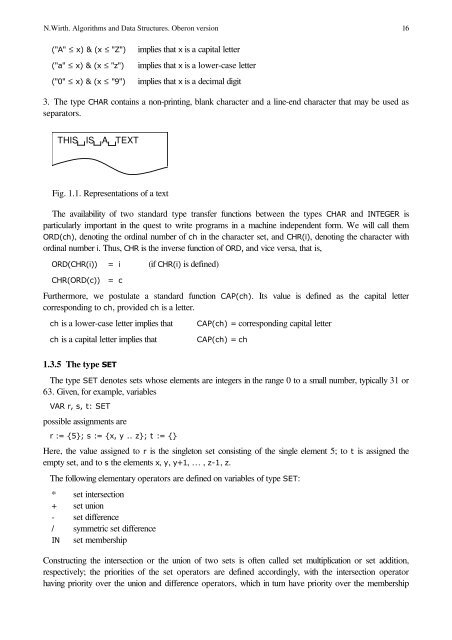Algorithms and Data Structures
Algorithms and Data Structures
Algorithms and Data Structures
Create successful ePaper yourself
Turn your PDF publications into a flip-book with our unique Google optimized e-Paper software.
N.Wirth. <strong>Algorithms</strong> <strong>and</strong> <strong>Data</strong> <strong>Structures</strong>. Oberon version 16<br />
("A" ≤ x) & (x ≤ "Z")<br />
("a" ≤ x) & (x ≤ "z")<br />
implies that x is a capital letter<br />
implies that x is a lower-case letter<br />
("0" ≤ x) & (x ≤ "9") implies that x is a decimal digit<br />
3. The type CHAR contains a non-printing, blank character <strong>and</strong> a line-end character that may be used as<br />
separators.<br />
THIS IS A TEXT<br />
Fig. 1.1. Representations of a text<br />
The availability of two st<strong>and</strong>ard type transfer functions between the types CHAR <strong>and</strong> INTEGER is<br />
particularly important in the quest to write programs in a machine independent form. We will call them<br />
ORD(ch), denoting the ordinal number of ch in the character set, <strong>and</strong> CHR(i), denoting the character with<br />
ordinal number i. Thus, CHR is the inverse function of ORD, <strong>and</strong> vice versa, that is,<br />
ORD(CHR(i)) = i (if CHR(i) is defined)<br />
CHR(ORD(c))<br />
= c<br />
Furthermore, we postulate a st<strong>and</strong>ard function CAP(ch). Its value is defined as the capital letter<br />
corresponding to ch, provided ch is a letter.<br />
ch is a lower-case letter implies that<br />
ch is a capital letter implies that<br />
CAP(ch) = corresponding capital letter<br />
CAP(ch) = ch<br />
1.3.5 The type SET<br />
The type SET denotes sets whose elements are integers in the range 0 to a small number, typically 31 or<br />
63. Given, for example, variables<br />
VAR r, s, t: SET<br />
possible assignments are<br />
r := {5}; s := {x, y .. z}; t := {}<br />
Here, the value assigned to r is the singleton set consisting of the single element 5; to t is assigned the<br />
empty set, <strong>and</strong> to s the elements x, y, y+1, … , z-1, z.<br />
The following elementary operators are defined on variables of type SET:<br />
* set intersection<br />
+ set union<br />
- set difference<br />
/ symmetric set difference<br />
IN set membership<br />
Constructing the intersection or the union of two sets is often called set multiplication or set addition,<br />
respectively; the priorities of the set operators are defined accordingly, with the intersection operator<br />
having priority over the union <strong>and</strong> difference operators, which in turn have priority over the membership
















